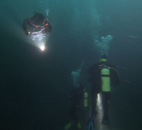Subfiend
Contributor
- Messages
- 153
- Reaction score
- 457
- # of dives
- I just don't log dives
Here is the screen shot from the video that DT used. Linnea is at 60 feet looking up, Nathan and Seth are ascending away from her, and Debbie is above looking down.Well, as I said earlier, I have not seen anything resembling instruction in these dives. If Linnae as the only one doing AOW, she would be the only one who could tell you what AOW dive was being done. Post 1,793 suggests she was doing the navigation dive, but your description show Snow doing the navigation. Perhaps she is demonstrating, but any such demonstration should have happened on the surface. The students are supposed to perform the skill under water.
The later certifications for the others defies belief.
I am sure you are aware that Snow foolishly participated in a FaceBook thread immediately after the incident in which she laid the blame on Bob, who was supposedly Linnae's buddy. This makes zero sense in regard to the video, since Snow obviously has to see how far separated they are and she has to be approving of it.
Of all the AOW dives, navigation is the most demanding of time and instructor engagement. If two people are doing it at the depths of this dive, I have run out of time (air supply) and had to do a second dive to complete the skills.
I have Debbie's social media posts.
I was surprised that PADI was still issuing certifications based on these dives two months after the fatality.




